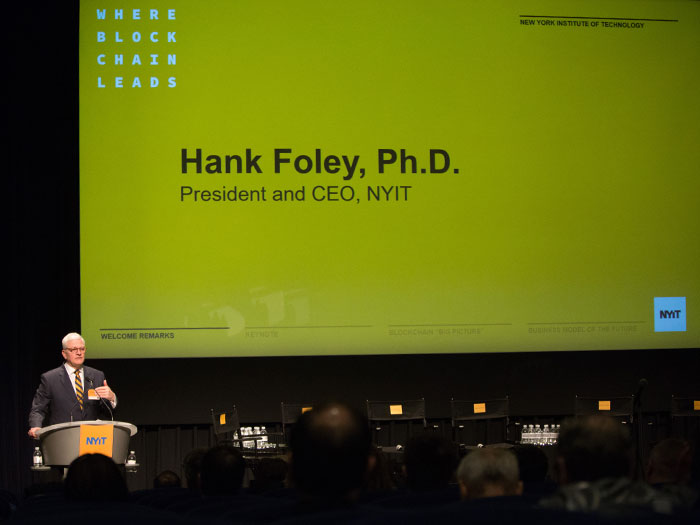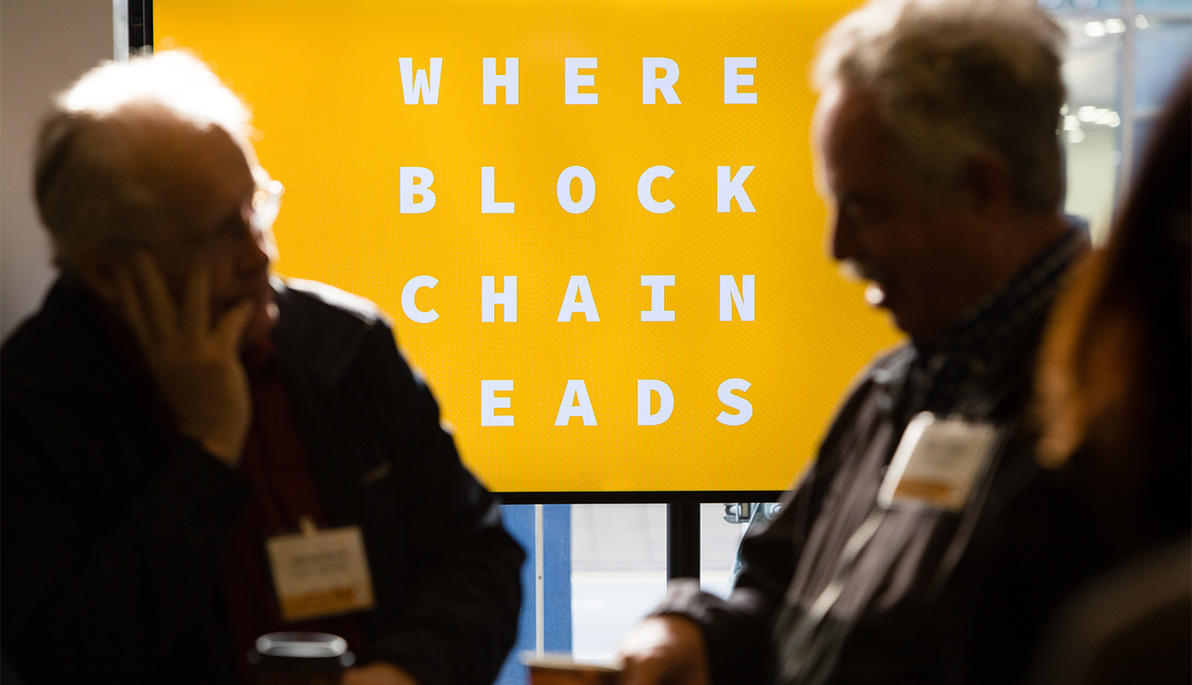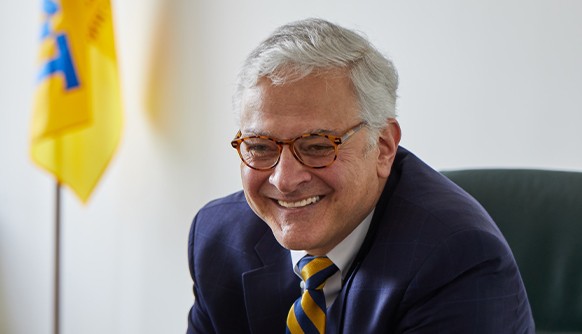News
Experts Gather to Determine “Where Blockchain Leads”
April 20, 2018
Panelists became prophets at “Where Blockchain Leads,” a conference held on April 12 at NYIT Auditorium on Broadway in New York City. Experts in the business and finance, technology, legal, and commerce sectors discussed the disruptive technology’s potential profits and pitfalls in two panel discussions led by Nada Anid, Ph.D., dean of NYIT School of Engineering and Computing Sciences, Jess Boronico, Ph.D., dean of NYIT School of Management, and Management Professor of Finance, Management, and Economics Steven Shapiro, Ph.D.
NYIT President Hank Foley, Ph.D., kicked off the symposium, part of a weeklong series of events celebrating his inauguration, by noting that “this marks the first time our institute has delved into exploring this emerging technology on a wide scale that invites scholars, scientists, academics, authors, industry experts, and other thought leaders to converge and collaborate on this important new technology.”

NYIT President Hank Foley, Ph.D., welcomed attendees to the blockchain symposium.
Foley, who posited that blockchain could be a more significant technological breakthrough than even the internet, penned an op-ed on blockchain’s potential in research activities in Scientific American on April 11. “Blockchain offers the possibility of doing massive disintermediation at scale. That is exciting and scary, depending on where you sit,” he noted.
Keynote speaker Teddy Wayne, New York Times journalist and author, offered his own insights, hopes, and concerns about the 10-year old technology: “It promotes peer-to-peer connections, eliminating the centralized government or banks while cutting costs of the middleman,” said Wayne, who spoke of myriad blockchain applications ranging from real supply-chain authentication to fraud control to medical records. He also noted the dangers of investing in over-hyped crypto-currencies, saying “I would caution to treat it like gambling and not get involved in day trading in the volatile crypto market as the profits often accrue to bots or colluding groups and not to individuals.”
As for blockchain taking over how we do business and conduct our day-to-day activities? “Any revolution won’t occur overnight,” said Wayne. “Most reasonable estimates suggest that mainstream adoption of the blockchain, if it is to happen at all, may take five to ten years. Perhaps young people [like the Parkland student gun control advocates] who are taking democratic principles into their own hands, will figure out how to harness the power of this new technology to make a more just and democratic society, and I hope that the rest of us will have the wisdom to give idealistic people like them our trust."
Watch the videos and read more below.
Welcome Remarks and Keynote Speaker
Panel 1: Blockchain “Big Picture”: Critical Cross-Industry Implementation & Impact
Panel 2: Business Model of the Future: Financial Applications & Implications of Blockchain
Watch Full Symposium on Facebook
In a subsequent panel, “Blockchain Big Picture,” technology and policy experts discussed the far-reaching implications of the new technology on commercial and creative ventures, including regulatory, process, and planning issues and the East Coast-West Coast mindsets regarding the development and applications of blockchain.
Chris Tse, CTO of Dot Blockchain Media, pointed to blockchain’s most promising attribute: “It’s a mechanism for trust. It provides an opportunity for parties to coordinate and convey transactions to ensure that not one entity is in control.” IBM Blockchain Academic Outreach’s Nikhil Gupta, concurred, sharing its commercial advantages: “It’s trusted and decentralized enough that suppliers and producers are all participating, and you can find out where something is in a matter of seconds.”
Panelists also spoke about the challenges all sectors face in relation to this disruptive technology—ranging from how the government regulates digital currencies (as a currency or commodity) to energy and storage/data needs to concerns about privacy.
“We believe we have a trusted process,” said Bob Graham, chairman and CEO, BlackRidge Technology. “How do we convince people that blockchain is more trustworthy. We have to prove it’s a trusted capability.”
The second panel, “Business Model of the Future,” picked up where the first group left off, focusing on the financial and operational aspects of blockchain technology as well as its potential in governmental and insurance sectors.
“Blockchain is going to be used to address complicated transactions that are grossly inefficient. This is actually going to transform the way we do business,” noted NYIT alumnus Richard J. Daly (B.S. ’74), CEO of Broadridge Financial Solutions. He also pointed out that it will create opportunities to “serve the underserved.”
“We’re investing in it,” said Maggie Parent, executive vice president for Voya Financial, “because we have a lot of irritating things we do every day that blockchain can help—so much of what we do is to-ing and fro-ing over a transaction.”
NYIT student Jonathan Brovda concurred: “There are real pain points that exist in the financial services sector right now, and we can fix those pain points with blockchain.”
Voya’s Parent summed up what many of the symposia experts and the keynote speaker surmised: “I think blockchain will under-deliver in the next five years and then massively over deliver.”





